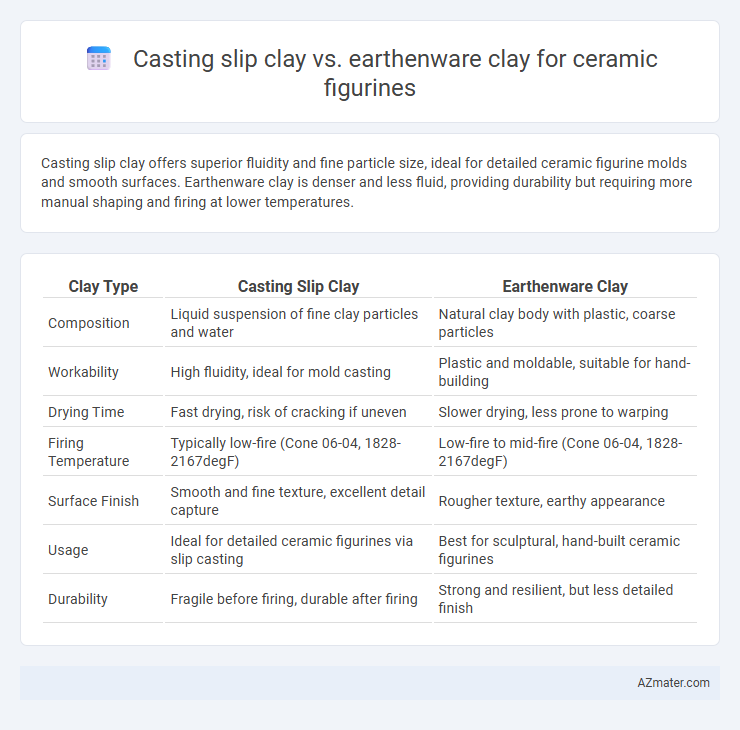Casting slip clay offers superior fluidity and fine particle size, ideal for detailed ceramic figurine molds and smooth surfaces. Earthenware clay is denser and less fluid, providing durability but requiring more manual shaping and firing at lower temperatures.
Table of Comparison
| Clay Type | Casting Slip Clay | Earthenware Clay |
|---|---|---|
| Composition | Liquid suspension of fine clay particles and water | Natural clay body with plastic, coarse particles |
| Workability | High fluidity, ideal for mold casting | Plastic and moldable, suitable for hand-building |
| Drying Time | Fast drying, risk of cracking if uneven | Slower drying, less prone to warping |
| Firing Temperature | Typically low-fire (Cone 06-04, 1828-2167degF) | Low-fire to mid-fire (Cone 06-04, 1828-2167degF) |
| Surface Finish | Smooth and fine texture, excellent detail capture | Rougher texture, earthy appearance |
| Usage | Ideal for detailed ceramic figurines via slip casting | Best for sculptural, hand-built ceramic figurines |
| Durability | Fragile before firing, durable after firing | Strong and resilient, but less detailed finish |
Understanding Casting Slip Clay
Casting slip clay offers a finer particle size and smoother consistency compared to earthenware clay, making it ideal for detailed ceramic figurines. This liquid clay form allows for precise mold reproduction and enables thin, delicate walls that improve the figurine's weight and texture. Its ability to flow easily into intricate molds ensures higher accuracy and reduces air bubbles that might compromise the finished piece.
What is Earthenware Clay?
Earthenware clay is a porous, soft clay fired at lower temperatures ranging from 1,000degC to 1,150degC, making it ideal for ceramic figurines requiring detailed hand modeling and vibrant glaze finishes. Unlike casting slip clay, which is a liquid form of clay used primarily for mold casting and producing thin-walled ceramics, earthenware clay offers greater plasticity and ease of manipulation, allowing artists to create intricate shapes and textures. Its natural iron content often gives earthenware a warm, reddish hue after firing, enhancing the aesthetic appeal of decorative figurines.
Key Differences Between Casting Slip and Earthenware Clay
Casting slip is a liquid clay mixture used primarily for slip casting in molds, offering fine details and producing lightweight, thin-walled ceramic figurines. Earthenware clay is a plastic, malleable material suitable for handbuilding or wheel throwing, resulting in thicker, sturdier pieces that are fired at lower temperatures. The key differences lie in their consistency, forming techniques, firing temperature, and the final texture and strength of ceramic figurines.
Workability for Figurine Detailing
Casting slip clay offers superior fluidity and fine particle consistency, enabling intricate detailing and smooth surface finishes essential for complex ceramic figurines. Earthenware clay, being coarser and less fluid, requires more manual manipulation and is better suited for simpler, less detailed figurines due to its lower workability. The choice between casting slip and earthenware clay directly impacts the precision and ease of sculpting fine features in ceramic figurines.
Drying and Shrinkage Rates
Casting slip clay offers a lower drying shrinkage rate of approximately 5-7%, making it ideal for detailed ceramic figurines requiring minimal warping during drying. Earthenware clay typically exhibits higher shrinkage rates around 10-15%, resulting in greater risk of cracking or distortion in thin or intricate areas. Controlled hydration and slow, even drying are essential for both materials to reduce structural stress and enhance final product integrity.
Firing Temperatures and Techniques
Casting slip clay for ceramic figurines typically requires lower firing temperatures, often between 1,800degF and 2,100degF (980degC to 1,150degC), allowing for precise detail capture and smooth surfaces, ideal for slip casting techniques. Earthenware clay fires at lower temperatures, around 1,830degF to 2,100degF (1,000degC to 1,150degC), making it porous and less vitrified, which is suitable for hand-building but less durable for intricate figurines. Understanding firing temperature ranges and clay properties ensures optimal strength and finish quality in ceramic figurines.
Surface Finishes: Glazing and Painting
Casting slip clay offers a smoother, more refined surface ideal for detailed ceramic figurines, enhancing the adhesion and evenness of glazes and paints. Earthenware clay, with its coarser texture and higher porosity, absorbs glazes differently, often resulting in a more rustic or matte finish that complements earthy color palettes. Both materials demand specific glaze formulations and firing temperatures to optimize durability and visual appeal on ceramic figurines.
Strength and Durability of Finished Figurines
Casting slip clay offers higher strength and finer detail due to its liquid consistency, allowing for more precise molds and fewer air bubbles, which enhances the durability of ceramic figurines. Earthenware clay, though easier to work with, tends to be more porous and less dense after firing, resulting in figurines that are more prone to chipping and less resistant to wear. The higher mechanical strength and reduced porosity of casting slip clay make it the preferred choice for creating robust and long-lasting ceramic figurines.
Ideal Applications for Each Clay Type
Casting slip clay is ideal for creating detailed, hollow ceramic figurines with fine surface textures and uniform thickness, commonly used in mass production and intricate designs. Earthenware clay suits hand-building or wheel-throwing solid figurines that benefit from its plasticity and warm, rustic finish, making it perfect for decorative, tactile artworks. Each clay type excels in different production methods: casting slip clay for precision casting molds and earthenware clay for artisanal craftsmanship.
Choosing the Best Clay for Your Ceramic Figurines
Casting slip clay offers fine particle consistency and excellent fluidity, making it ideal for detailed ceramic figurine molds requiring smooth surfaces. Earthenware clay, with its coarser texture and higher plasticity, suits hand-building techniques but may lack the refined finish casting slip provides. Selecting the best clay depends on the figurine's design intricacy and production method, prioritizing casting slip for precision and earthenware for tactile, sculptural work.

Infographic: Casting slip clay vs Earthenware clay for Ceramic figurine
 azmater.com
azmater.com